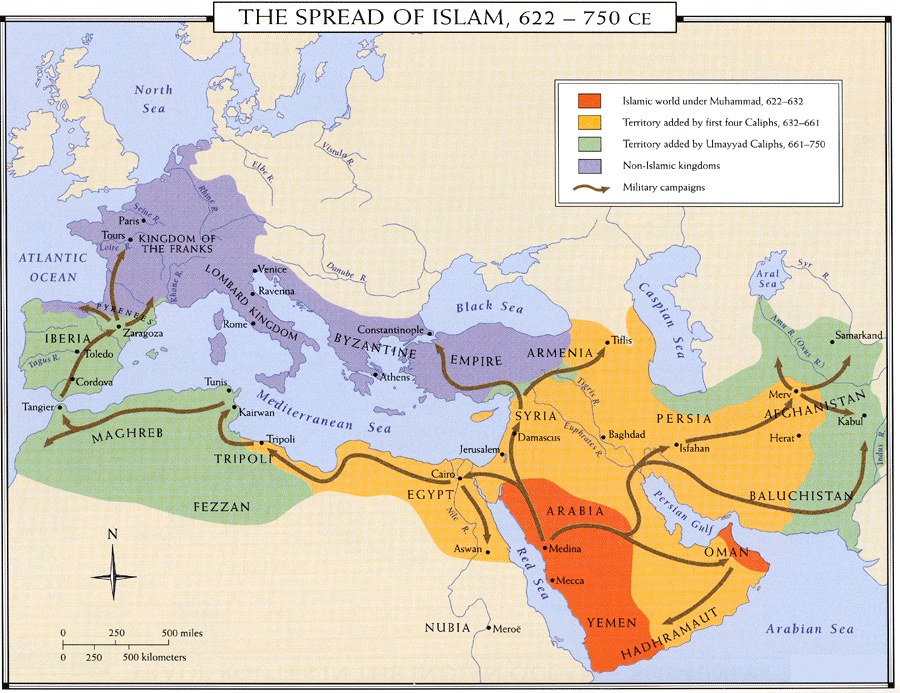Spread of islam through trade routes
Multiple Trajectories of Islam in Africa Islam had already spread into northern Africa by the mid-seventh century A.
Given its negotiated, practical approach to different cultural situations, it is perhaps more appropriate to consider Islam in Africa in terms of its multiple histories rather then as a unified movement. The first converts were the Sudanese merchants, followed by a few rulers and courtiers Ghana in the eleventh century and Mali in the thirteenth century.
The masses of rural peasants, however, remained little touched. In the eleventh century, the Almoravid intervention , led by a group of Berber nomads who were strict observers of Islamic law, gave the conversion process a new momentum in the Ghana empire and beyond.
How Did Trade Help Spread Early Islam? | Our Everyday Life
The spread of Islam throughout the African continent was neither simultaneous nor uniform, but followed a gradual and adaptive path. However, the only written documents at our disposal for the period under consideration derive from Arab sources see, for instance, accounts by geographers al-Bakri and Ibn Battuta.
Islamic Influence on African Societies Islamic political and aesthetic influences on African societies remain difficult to assess.
In some capital cities, such as Ghana and Gao, the presence of Muslim merchants resulted in the establishment of mosques. The Malian king Mansa Musa r.
Islam brought to Africa the art of writing and new techniques of weighting. The city of Timbuktu, for instance, flourished as a commercial and intellectual center, seemingly undisturbed by various upheavals. Timbuktu began as a Tuareg settlement, was soon integrated into the Mali empire , then was reclaimed by the Tuareg, and finally incorporated into the Songhai empire. In the sixteenth century, the majority of Muslim scholars in Timbuktu were of Sudanese origin.
On the other hand, in many cases conversion for sub-Saharan Africans was probably a way to protect themselves against being sold into slavery, a flourishing trade between Lake Chad and the Mediterranean. For their rulers, who were not active proselytizers, conversion remained somewhat formal, a gesture perhaps aimed at gaining political support from the Arabs and facilitating commercial relationships.

These amulets are featured in the design of many traditional African artifacts. Islam also reinforced the African fondness for geometric design and the repetition of patterns in decorating the surface of textiles and crafted objects. Local weaving may have been transformed with the importation of North African weaving techniques. Islam has also often existed side by side with representational traditions such as masquerading.
Such practices have often been viewed as supplemental rather than oppositional to Islam, particularly when they are seen as effective or operating outside of the central concerns of the faith. An early example of this was noted by Ibn Battuta, the Maghribi scholar who visited Mali in —53 and witnessed a masquerade performance at the royal court of its Muslim king.
Spread of Islam - Wikipedia
In many areas of Africa, the coexistence of Islam with representational art forms continues today. But although Islam has influenced a wide range of artistic practices in Africa since its introduction, monumental architecture is the best-preserved legacy of its early history on the continent. Mosques are the most important architectural examples of the tremendous aesthetic diversity generated by the interaction between African peoples and Islamic faith.
Department of the Arts of Africa, Oceania, and the Americas , The Metropolitan Museum of Art.
Trade and the Spread of Islam in Africa | Essay | Heilbrunn Timeline of Art History | The Metropolitan Museum of Art
Department of the Arts of Africa, Oceania, and the Americas. The Metropolitan Museum of Art, —. Islam and Tribal Art in West Africa. Cambridge University Press, Essay Multiple Trajectories of Islam in Africa Islam had already spread into northern Africa by the mid-seventh century A.
Department of the Arts of Africa, Oceania, and the Americas , The Metropolitan Museum of Art October Citation Department of the Arts of Africa, Oceania, and the Americas. Related Primary Essays The Birth of Islam The Empires of the Western Sudan Figural Representation in Islamic Art Geometric Patterns in Islamic Art The Nature of Islamic Art.
Secondary Essays African Christianity in Ethiopia African Lost-Wax Casting: Bronze, Copper, and Brass Antelopes and Queens: Bambara Sculpture from the Western Sudan: A Groundbreaking Exhibition at the Museum of Primitive Art, New York, The Art of the Almoravid and Almohad Periods ca.
Maroserana and Merina Monumental Architecture and Stelae of the Aksumite Empire The Rock-hewn Churches of Lalibela Trade Relations among European and African Nations Trade and Commercial Activity in the Byzantine and Early Islamic Middle East The Trans-Saharan Gold Trade Seventh—Fourteenth Centuries Turkmen Jewelry Tutsi Basketry. List of Rulers List of Rulers of the Islamic World.
Chronology Eastern Africa, — A.
Eastern Africa, — A. Eastern and Southern Africa, — A. Western and Central Sudan, — A. Map Trade and the Spread of Islam in Africa. Keywords Africa Amulet Animal Arabian Peninsula Architecture Bamana Art Bwa Art Eastern Africa Ethiopia Geometry Islam Islamic Art Islamic Art in the Early Period Islamic Art in the Later Period Islamic Art in the Medieval Period Maasai Art Mali Mosque Mossi Art Muhammad North Africa Religious Art Somali Art Southern Africa Spain Tellem Art Trade Western Africa Western and Central Sudan.
See Also All essays, African Art All essays, African Art: Central Africa All essays, African Art: Eastern Africa All essays, African Art: Southern Africa All essays, African Art: Western Africa All essays, Islamic Art All essays, Islamic Art: Early Period All essays, Islamic Art: Later Period All essays, Islamic Art: About Rights and Permissions Print Share.